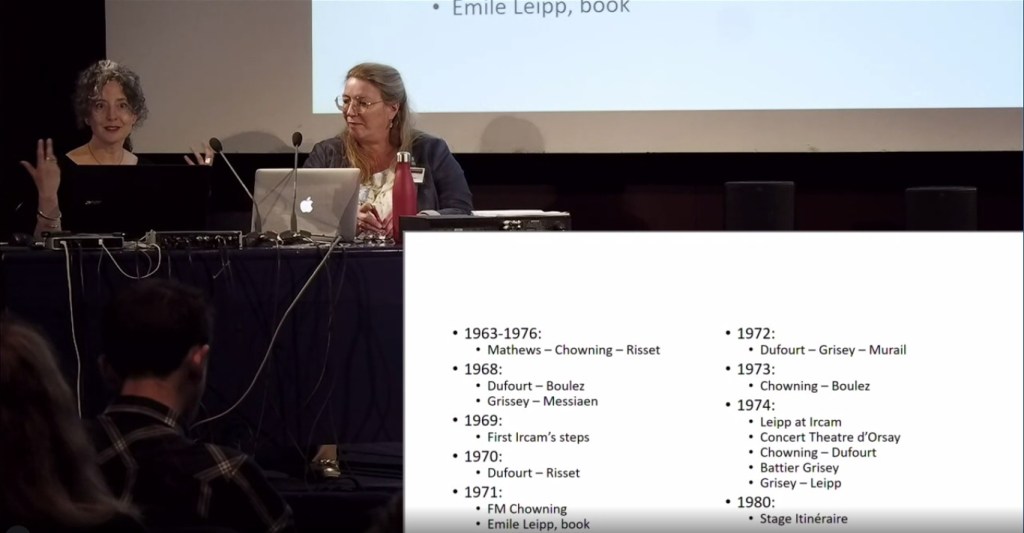My talk “Behind the official literature. A history of first encounters between Spectralists and Sound Researchers” is now online.
Link to video: https://medias.ircam.fr/embed/media/x8a75e6

It is a recognized fact that studies such the ones developed by Jean-Claude Risset [2], John Chowning [2] and Joseph Fourier [3] on psychoacoustic, synthesis and sound representation, have opened the door to the development of French Spectralist music. Throughout the pages of literature, now historical, may be found the presence of writings of composers and researchers side by side which, read in the light of subsequent developments, shows the deep importance of this bond (one example is the collection of writings in [4] and [5]).
In Hugues Dufourt’s La musique spectrale. Une révolution épistémologique (2014), to take just one notable example in the recent literature, the index of names emphasises the importance of Chowning (46 entries) Risset (77 entries), as well as Fourier, Hermann von Helmholtz, Max Mathews, Stephen McAdams, John Pierce, James A. Moorer and David Wessel. As Dufourt said during a radio interview in 2016: thanks to the use of computer, «by changing scale, music has changed its language. Timbral objects, found for example by Risset, are essentially models of knowledge of certain acoustic phenomena», and again: «to me, spectral music would not have been possible without the transformation introduced by sound synthesis» (ivi, 461).
What is less known though are the historical facts of the many connections between those researchers and spectral composers. In August 1975, a team from the future Ircam attended a ten-day intensive seminar at CCRMA (founded by Chowning); the team included Pierre Boulez, Luciano Berio and Risset, who would each become the head of one of IRCAM departments in 1976 (Chowning, unpublished digital letter, 20 June 1977). Désintégrations (1982-83) by Tristan Murail is heavily influenced by his experience in 1980 at Ircam, during his (and others composers from the ensemble Itinéraire) participation in a computer music workshop. Gérard Grisey studied acoustics with Emile Leipp at the University of Jussieu in the early 1970s on the instrumental spectra.
In this presentation I focus on the historical reconstruction of the exchanges and influences between sound researchers and the first Spectral composers. I will follow the early steps, meetings and interactions between them. I will try to answer to questions as such in which way these connections took place, when and how these meeting took place, and possibly to find and follow relevant in/visible actors.
My research is based on oral history, and published and unpublished literature dedicated to Spectral Music. Oral history and STS (Science and Technology Studies) methodologies will be necessary means to trace this history, to outline the contours of the social impact this culture of science and technology had on Spectralism, and vice-versa to find the reciprocal influence the compositional writing had on the development of technology.
[1] Risset, J.-C., Introductory Catalogue of Computer Synthesized Sounds, 1969.
[2] Chowning, J., The Synthesis of Complex Audio Spectra by Means of Frequency Modulation. Journal of the audio engineering society, 21/7, 526-534.
[3] Dufourt, H., La révolution silencieuse de Joseph Fourier, talk presented at the Joseph Fourier Society, 2018.
[4] Barrière J.-B. (ed.), Le timbre- métaphore pour la composition. Paris : Christian Bourgois Editeur / IRCAM, 1991.
[5] Fineberg, J. (ed.), Spectral Music: History and Techniques. Special issue of Contemporary Music Review, Vol. 19 (2 and 3), 2000.


Leave a comment